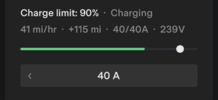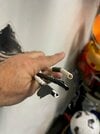I just got the Tesla wall charger gen3 installed. The electrician brought a 50 amp breaker instead of 60 amp. He said he will come back to swap the break. However, looking at the app and charging right now, I'm getting 41 mi/hr at 40a which is slightly higher than the 37 mi/hr as stated on the installation manual.
Question, what are your experiences with 60 amp breaker output? Is it worth asking the electrician to come back and swap the 50 amp for 60 amp breaker?
Question, what are your experiences with 60 amp breaker output? Is it worth asking the electrician to come back and swap the 50 amp for 60 amp breaker?




